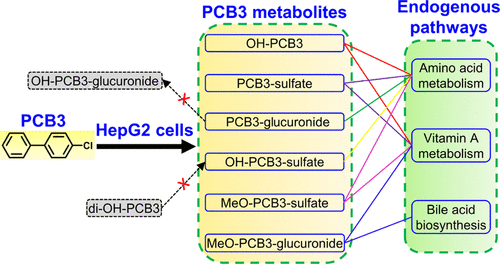当前位置:
X-MOL 学术
›
Environ. Sci. Technol.
›
论文详情
Our official English website, www.x-mol.net, welcomes your
feedback! (Note: you will need to create a separate account there.)
Characterization of the Metabolic Pathways of 4-Chlorobiphenyl (PCB3) in HepG2 Cells Using the Metabolite Profiles of Its Hydroxylated Metabolites
Environmental Science & Technology ( IF 10.8 ) Pub Date : 2021-06-14 , DOI: 10.1021/acs.est.1c01076 Chun-Yun Zhang 1 , Susanne Flor 1 , Patricia Ruiz 2 , Gabriele Ludewig 1 , Hans-Joachim Lehmler 1
Environmental Science & Technology ( IF 10.8 ) Pub Date : 2021-06-14 , DOI: 10.1021/acs.est.1c01076 Chun-Yun Zhang 1 , Susanne Flor 1 , Patricia Ruiz 2 , Gabriele Ludewig 1 , Hans-Joachim Lehmler 1
Affiliation

|
The characterization of the metabolism of lower chlorinated PCB, such as 4-chlorobiphenyl (PCB3), is challenging because of the complex metabolite mixtures formed in vitro and in vivo. We performed parallel metabolism studies with PCB3 and its hydroxylated metabolites to characterize the metabolism of PCB3 in HepG2 cells using nontarget high-resolution mass spectrometry (Nt-HRMS). Briefly, HepG2 cells were exposed for 24 h to 10 μM PCB3 or its seven hydroxylated metabolites in DMSO or DMSO alone. Six classes of metabolites were identified with Nt-HRMS in the culture medium exposed to PCB3, including monosubstituted metabolites at the 3′-, 4′-, 3-, and 4- (1,2-shift product) positions and disubstituted metabolites at the 3′,4′-position. 3′,4′-Di-OH-3 (4′-chloro-3,4-dihydroxybiphenyl), which can be oxidized to a reactive and toxic PCB3 quinone, was a central metabolite that was rapidly methylated. The resulting hydroxylated-methoxylated metabolites underwent further sulfation and, to a lesser extent, glucuronidation. Metabolomic analyses revealed an altered tryptophan metabolism in HepG2 cells following PCB3 exposure. Some PCB3 metabolites were associated with alterations of endogenous metabolic pathways, including amino acid metabolism, vitamin A (retinol) metabolism, and bile acid biosynthesis. In-depth studies are needed to investigate the toxicities of PCB3 metabolites, especially the 3′,4′-di-OH-3 derivatives identified in this study.
中文翻译:

使用其羟基化代谢物的代谢物谱表征 4-氯联苯 (PCB3) 在 HepG2 细胞中的代谢途径
由于在体外和体内形成复杂的代谢物混合物,因此对 4-氯联苯 (PCB3) 等低氯化 PCB 的代谢进行表征具有挑战性. 我们对 PCB3 及其羟基化代谢物进行了平行代谢研究,以使用非目标高分辨率质谱 (Nt-HRMS) 表征 HepG2 细胞中 PCB3 的代谢。简而言之,将 HepG2 细胞暴露于 DMSO 或 DMSO 中的 10 μM PCB3 或其七种羟基化代谢物 24 小时。在暴露于 PCB3 的培养基中用 Nt-HRMS 鉴定了六类代谢物,包括位于 3'-、4'-、3- 和 4-(1,2-移位产物)位置的单取代代谢物和位于3',4'-位置。3',4'-Di-OH-3(4'-氯-3,4-二羟基联苯)可被氧化成反应性和有毒的PCB3醌,是一种快速甲基化的中心代谢物。所得羟基化甲氧基化代谢物进一步硫酸化,并在较小程度上进行葡萄糖醛酸化。代谢组学分析显示,接触 PCB3 后 HepG2 细胞中的色氨酸代谢发生了改变。一些 PCB3 代谢物与内源性代谢途径的改变有关,包括氨基酸代谢、维生素 A(视黄醇)代谢和胆汁酸生物合成。需要深入研究 PCB3 代谢物的毒性,尤其是本研究中鉴定的 3',4'-di-OH-3 衍生物。
更新日期:2021-07-06
中文翻译:

使用其羟基化代谢物的代谢物谱表征 4-氯联苯 (PCB3) 在 HepG2 细胞中的代谢途径
由于在体外和体内形成复杂的代谢物混合物,因此对 4-氯联苯 (PCB3) 等低氯化 PCB 的代谢进行表征具有挑战性. 我们对 PCB3 及其羟基化代谢物进行了平行代谢研究,以使用非目标高分辨率质谱 (Nt-HRMS) 表征 HepG2 细胞中 PCB3 的代谢。简而言之,将 HepG2 细胞暴露于 DMSO 或 DMSO 中的 10 μM PCB3 或其七种羟基化代谢物 24 小时。在暴露于 PCB3 的培养基中用 Nt-HRMS 鉴定了六类代谢物,包括位于 3'-、4'-、3- 和 4-(1,2-移位产物)位置的单取代代谢物和位于3',4'-位置。3',4'-Di-OH-3(4'-氯-3,4-二羟基联苯)可被氧化成反应性和有毒的PCB3醌,是一种快速甲基化的中心代谢物。所得羟基化甲氧基化代谢物进一步硫酸化,并在较小程度上进行葡萄糖醛酸化。代谢组学分析显示,接触 PCB3 后 HepG2 细胞中的色氨酸代谢发生了改变。一些 PCB3 代谢物与内源性代谢途径的改变有关,包括氨基酸代谢、维生素 A(视黄醇)代谢和胆汁酸生物合成。需要深入研究 PCB3 代谢物的毒性,尤其是本研究中鉴定的 3',4'-di-OH-3 衍生物。











































 京公网安备 11010802027423号
京公网安备 11010802027423号